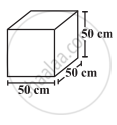Advertisements
Advertisements
Question
There are two cuboidal boxes as shown in the adjoining figure. Which box requires the lesser amount of material to make?
 |
 |
| (a) | (b) |
Solution
For this we find their areas -
(a) Length of the first box (l) = 60 cm
Width of first box (b) = 40 cm
Height of first box (h) = 50 cm
Total surface area of first box = 2(lb + bh + hl)
= 2(60 × 40 + 40 × 50 + 50 × 60)
= 2(2400 + 2000 + 3000)
= 2 × 7400
= 14800 cm2
(b) Length of the second box (l) = 50 cm
Width of second box (D) = 50 cm
Height of second box (h) = 50 cm
Total surface area of second box = 2(lb + bh + hl)
= 2(50 × 50 + 50 × 50 + 50 × 50)
= 2(2500 + 2500 + 2500)
= 2 × 7500
= 15000 cm2
Here the area of the first box is less. Hence, less material is required to make it.
APPEARS IN
RELATED QUESTIONS
The floor of a rectangular hall has a perimeter 250 m. If the cost of panting the four walls at the rate of Rs.10 per m2 is Rs.15000, find the height of the hall.
[Hint: Area of the four walls = Lateral surface area.]
The paint in a certain container is sufficient to paint an area equal to 9.375 m2. How many bricks of dimensions 22.5 cm × 10 cm × 7.5 cm can be painted out of this container?
What will happen to the volume of a cuboid if its Length is doubled, height is doubled and breadth is sama?
If the volumes of two cubes are in the ratio 8: 1, then the ratio of their edges is
The surface area of a cuboid is 1300 cm2. If its breadth is 10 cm and height is 20 cm2, find its length.
10 cubic metres clay is uniformly spread on a land of area 10 ares. the rise in the level of the ground is
The height of a rectangular solid is 5 times its width and its length is 8 times its height. If the volume of the wall is 102.4 cm3, find its length.
Find the height of the cylinder whose radius is 7 cm and the total surface area is 1100 cm2.
Find the volume of a cuboid whose diagonal is `3sqrt(29)"cm"` when its length, breadth and height are in the ratio 2 : 3 : 4.
All six faces of a cuboid are ______ in shape and of ______ area.
